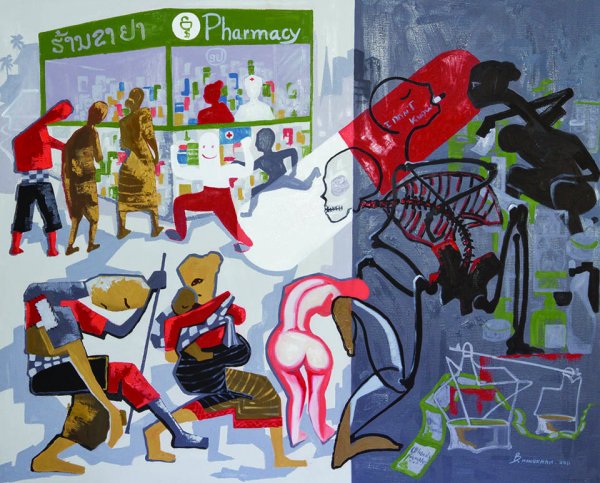Artists explore the problems of poor quality and fake medicines
When we are ill, we trust that the medicines that we take will make us feel and be better. But what if our pills do not contain the ingredients listed on the packaging? The art exhibition ‘What’s in your medicines?’ explores how substandard and falsified (‘fake’) medicines can affect our health, by showcasing the striking and original artwork of 12 South East Asian artists.

The exhibition is organised by the Infectious Diseases Data Observatory (IDDO) and the Medicine Quality Research Group from the Lao-Oxford-Mahosot Hospital Wellcome Trust Research Unit (LOMWRU) based in Laos. It will launch on 22 October 2019 at the ‘Arts and Science’ event hosted by the Institut de Recherche pour le Développement (IRD) at the French Institute of Laos.
Not many people know that substandard (due to errors in factories) and falsified (‘fake’, due to fraud) medicines and vaccines are a big problem, especially affecting low- and mid-income countries in South East Asia and Africa. The World Health Organization estimates that in these countries around 10% of medicines are of poor quality. However, the true extent of the problem is still not known. Substandard and falsified medicines can prolong sickness, cause serious side effects, put pressure on doctors and hospitals, and damage people’s trust in health care. They are also likely to contribute to the rise of antimicrobial resistance: microorganisms like malaria parasites can become resistant to medicines, if the dose taken is too low.
The exhibition, originally called ‘PHARMACIDE ARTS – Fake medicine: the disease of greed’, was created by the United States Pharmacopeia (funded by USAID), the French Government and other partners in 2011. It toured Cambodia, Laos, Indonesia, Thailand and Vietnam in 2012, and now returns to South East Asia in 2019/20. The second tour of the exhibition is funded by a Wellcome Trust Provision for Public Engagement and supported by the Mahidol Oxford Tropical Medicine Research Unit (MORU) in Bangkok, Thailand.
The exhibition officially opens on 22nd October 2019 at 7.30 pm at the French Institute of Laos and will be open to visitors until 2nd November 2019, from 9am to 5pm. Entry is free and no ticket booking is required.
About Medicine Quality
The Medicine Quality Research Group at IDDO/LOMWRU, led by Professor Paul Newton and Dr Céline Caillet, investigates the distribution, detection methods and impact of substandard and falsified medicines in South East Asia and around the world. For more information view podcasts with Paul Newton on Poor quality medicines and Céline Caillet discussing Improving medicine quality.
For more information, please contact medicinequality@iddo.org
